- Publisher's Note
- Editorial
- Looking from the Other Side
- Women in Rabindranath Tagore's Paintings
- Ramkinkar Baij's Santhal Family
- The Birth of Freedom in Moments of Confinement
- Jamini Roy's Art in Retrospect
- The Great Journey of Shapes: Collages of Nandalal Bose
- Haripura Posters by Nandalal Bose: The Context and the Content
- The Post-1960s Scenario in the Art of Bengal
- Art Practice in and Around Kolkata
- Social Concern and Protest
- The Dangers of Deifications
- Gobardhan Ash: The Committed Artist of 1940-s
- Gopal Ghose
- Painting of Dharmanarayan Dasgupta: Social Critique through Fantasy and Satire
- Asit Mondal: Eloquence of Lines
- The Experiential and Aesthetic Works of Samindranath Majumdar
- Luke Jerram: Investigating the Acoustics of Architecture
- Miho Museum: A Structure Embedded in the Landscape
- Antique Victorian Silver
- Up to 78 Million American Dollars1 !
- Random Strokes
- Are We Looking At the Rise of Bengal
- Art Basel and the Questions it Threw Up
- What Happened and What's Forthcoming
- Art Events Kolkata, May – June 2012
- Mumbai Art Sighting
- Delhi Dias
- Art Bengaluru
- Preview June, 2012 – July, 2012
- In the News, June 2012
ART news & views
Up to 78 Million American Dollars1 !
Issue No: 30 Month: 7 Year: 2012
by Franck Barthelemy
Every year in June, Basel becomes the Mecca of the Arts, a pilgrimage no art aficionado would miss. Hotels are sold out. Taxi drivers are happy. Trams are full. Art lovers from all over the continents flock to the quiet bourgeois city to attend the biggest art fair in the world, Art Basel. Founded in 1970 by one of the most influential gallerists, Ernst Beyeler, and a few friends, it has become the art event benchmark. Over a thousand galleries send their applications every year hoping to be selected and be part of the very private club of Art Basel's exhibitors. Only a third of them are selected and the selection is tough (sometimes surprising also). This year, three hundred galleries came from thirty six countries to show case over two thousand five hundred 20th and 21st centuries' artists. And sadly, only two galleries from India made it.
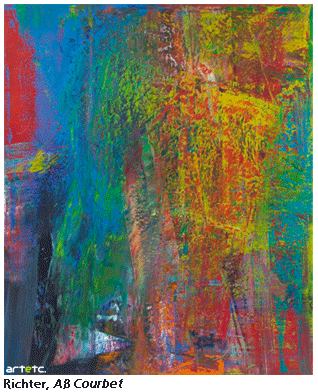
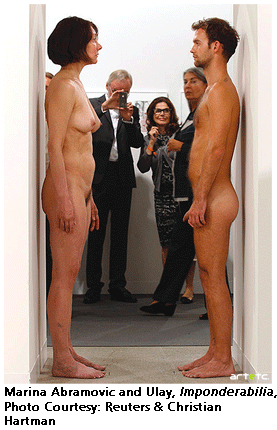 For four days, Art Galleries, the heart of the fair, becomes a posh market for the arts. This year, two extra days were dedicated to regular buyers and selected happy few, the 'First Choice' invitees. They could access the alleys of the fair before the public rush and before the very trendy vernissage. They could also book art works discreetly, without any pressure. When the so called VIPs came in, after having stood up quite a while in the long line at the main gate, in Dior's outfits and high heels for ladies and fitted suits and designers' shoes for men, many works were already sold, the gallerists exhibiting proudly the traditional red dots on them. AB Courbet, an abstract painting by German artist Gerard Richter was reported to be sold the first day to an American buyer for 20 to 25 million dollars. A beautiful untitled 1954 Rothko from a Swiss collection caught many collectors' eyes said to be from South America and Russia and ready to spend about 78 million dollars, the highest price tag this year. Many stabile and mobile by Calder could be seen all around: a wooden stabile was particularly stunning for its beauty and originality. Dubuffet was also a hit this year: great quality paintings and sculptures were spotted in large numbers (and quite sought after by collectors). Marina Abramovic's performance Imponderabilia brought a bit of spice, laughs and comments. A naked man facing a naked woman stood at the door of a gallery's space; to get in, the visitor had to slip between them with an interesting question in mind: which one should I face?
For four days, Art Galleries, the heart of the fair, becomes a posh market for the arts. This year, two extra days were dedicated to regular buyers and selected happy few, the 'First Choice' invitees. They could access the alleys of the fair before the public rush and before the very trendy vernissage. They could also book art works discreetly, without any pressure. When the so called VIPs came in, after having stood up quite a while in the long line at the main gate, in Dior's outfits and high heels for ladies and fitted suits and designers' shoes for men, many works were already sold, the gallerists exhibiting proudly the traditional red dots on them. AB Courbet, an abstract painting by German artist Gerard Richter was reported to be sold the first day to an American buyer for 20 to 25 million dollars. A beautiful untitled 1954 Rothko from a Swiss collection caught many collectors' eyes said to be from South America and Russia and ready to spend about 78 million dollars, the highest price tag this year. Many stabile and mobile by Calder could be seen all around: a wooden stabile was particularly stunning for its beauty and originality. Dubuffet was also a hit this year: great quality paintings and sculptures were spotted in large numbers (and quite sought after by collectors). Marina Abramovic's performance Imponderabilia brought a bit of spice, laughs and comments. A naked man facing a naked woman stood at the door of a gallery's space; to get in, the visitor had to slip between them with an interesting question in mind: which one should I face?
Besides the master artists' works selling in millions of dollars, many younger artists' works found their ways to collections. There is no doubt that being showed at Basel is a big commercial push in any careers. But sometimes the quality of the pieces is surprisingly average. And sometimes the originality is questionable. As a viewer and a collector, I am always happy to recognise a piece work. I then look at the tag to confirm my first impression to sadly realize it is not the work I thought it was. But it is so similar! How can two pieces of work from two different artists be so identical I wonder? Is there something in the air that is too inspirational?
A feature of the year's edition of the fair is perhaps the comeback of the American buyers after two years of absence. They are usually risk averse and ready to gamble on younger names supported by galleries. Some dealers were complaining though about the lack of interest for established artists with reasonable price tags (not in multi million dollars). And this is probably a contradiction in today's market: the affordable art works and the very expensive ones are selling. The rest is in a lacklustre. Considering the smiles and the red dots when the fair opened to the general public, the exhibitors grab the market dynamics pretty well and the fair was already a commercial success.
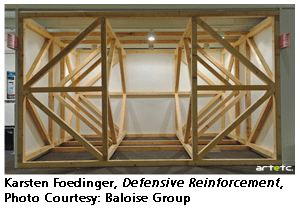 Besides being a museum where the most influential galleries in the world offer master works for sale, Art Basel allow upcoming galleries to make a statement with new artists with Art Statement. Since 1996, about 20 projects are selected every year from about 300 applications. The Basel based Baloise Group is associated to it for more than a decade and rewards two artists selected by a jury of well recognized art professionals. This year, Simon Denny from New Zealand and Karsten Födinger from Germany pocketed the cash prize of 2 million Indian rupees2 each. The Baloise will also acquire the works of the winners and donate them to leading museums in Europe. No need to say that India is still waiting for her Baloise counterpart to consistently support young artists and their works.
Besides being a museum where the most influential galleries in the world offer master works for sale, Art Basel allow upcoming galleries to make a statement with new artists with Art Statement. Since 1996, about 20 projects are selected every year from about 300 applications. The Basel based Baloise Group is associated to it for more than a decade and rewards two artists selected by a jury of well recognized art professionals. This year, Simon Denny from New Zealand and Karsten Födinger from Germany pocketed the cash prize of 2 million Indian rupees2 each. The Baloise will also acquire the works of the winners and donate them to leading museums in Europe. No need to say that India is still waiting for her Baloise counterpart to consistently support young artists and their works.
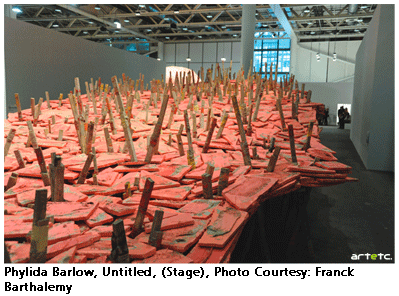
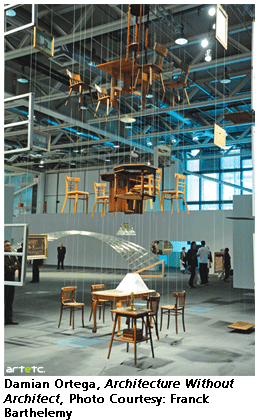
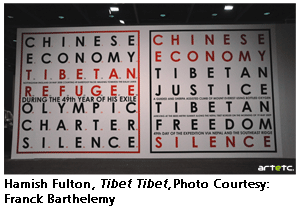 As many might have noticed, if you give space to an artist, he/she will manage to occupy it without any problem. And the galleries struggle to show this kind of works in traditional exhibition spaces. Art Unlimited has been created in 2000 in order to exhibit large scale projects and give the buyers/viewers a real life size feeling of the works. About 60 installations and videos were displayed this year. I particularly liked Damian Ortega's Architecture Without Architects (2010) where elements defining three living rooms are hung from the ceiling, deconstructing and reconstructing the everyday; Hamish Fulton's Tibet Tibet (2008/9) where the artist challenges the absence of reaction and criticism about Tibet crisis from any governments not to jeopardize their relationship with China; Phyllida Barlow's Stage (2011) where she constructed a huge pink platform made of cheap recycled materials to interact with the viewers; Rudolf Stingel's Paula (2012) where the artist displayed a very large oil on canvas looking like a photograph painting in a white room exploring the his redefinition of a painting; Wang Jianwei's Symptom (2007/8), an immersing video where he explores the notion of symptom as seen by doctors as well as Marx and Althusser.
As many might have noticed, if you give space to an artist, he/she will manage to occupy it without any problem. And the galleries struggle to show this kind of works in traditional exhibition spaces. Art Unlimited has been created in 2000 in order to exhibit large scale projects and give the buyers/viewers a real life size feeling of the works. About 60 installations and videos were displayed this year. I particularly liked Damian Ortega's Architecture Without Architects (2010) where elements defining three living rooms are hung from the ceiling, deconstructing and reconstructing the everyday; Hamish Fulton's Tibet Tibet (2008/9) where the artist challenges the absence of reaction and criticism about Tibet crisis from any governments not to jeopardize their relationship with China; Phyllida Barlow's Stage (2011) where she constructed a huge pink platform made of cheap recycled materials to interact with the viewers; Rudolf Stingel's Paula (2012) where the artist displayed a very large oil on canvas looking like a photograph painting in a white room exploring the his redefinition of a painting; Wang Jianwei's Symptom (2007/8), an immersing video where he explores the notion of symptom as seen by doctors as well as Marx and Althusser.

 The organizers have put together various interactive opportunities for visitors: Art Parcours displaying art in public spaces across the city; Art Film showcasing the latest movies; Art Conversations to listen to and questions the artists. The visitors breathe art extensively. And to wrap up the experience, the city museums and art institutions take their bit of responsibilities to enhance the visitors' experience by organizing major exhibitions around Art Basel. The Beyerler Foundation, for instance, organized the Jeff Koons' exhibition The New, Banality and Celebration. 25 works from 1980 to 2011 are shown, some of them for the first time. Koon's followers will recognize early works with readymade cleaning appliances, porcelain works that have become iconic, high-gloss steel sculptures and large format paintings. The just complete Balloon Swan captures elements of childhood toys the artist turned into a cult figure. Perhaps a bit controversial, but surely well done. In a very different style, the Kuntsmuseum organized Renoir, Between Bohemia and Bourgeoisie. Nina Zimmer, the curator, put together early years' paintings, landscapes, portraits and still-lifes, Renoir produced before becoming one of the leading impressionists in the 1870s. Besides being absolutely beautiful, this one of its kind exhibition sounds like a reminder in the ocean of contemporary art: there was something interesting before too!
The organizers have put together various interactive opportunities for visitors: Art Parcours displaying art in public spaces across the city; Art Film showcasing the latest movies; Art Conversations to listen to and questions the artists. The visitors breathe art extensively. And to wrap up the experience, the city museums and art institutions take their bit of responsibilities to enhance the visitors' experience by organizing major exhibitions around Art Basel. The Beyerler Foundation, for instance, organized the Jeff Koons' exhibition The New, Banality and Celebration. 25 works from 1980 to 2011 are shown, some of them for the first time. Koon's followers will recognize early works with readymade cleaning appliances, porcelain works that have become iconic, high-gloss steel sculptures and large format paintings. The just complete Balloon Swan captures elements of childhood toys the artist turned into a cult figure. Perhaps a bit controversial, but surely well done. In a very different style, the Kuntsmuseum organized Renoir, Between Bohemia and Bourgeoisie. Nina Zimmer, the curator, put together early years' paintings, landscapes, portraits and still-lifes, Renoir produced before becoming one of the leading impressionists in the 1870s. Besides being absolutely beautiful, this one of its kind exhibition sounds like a reminder in the ocean of contemporary art: there was something interesting before too!
Reference
1 Approx. INR 429 Crores
2 CH 30,000